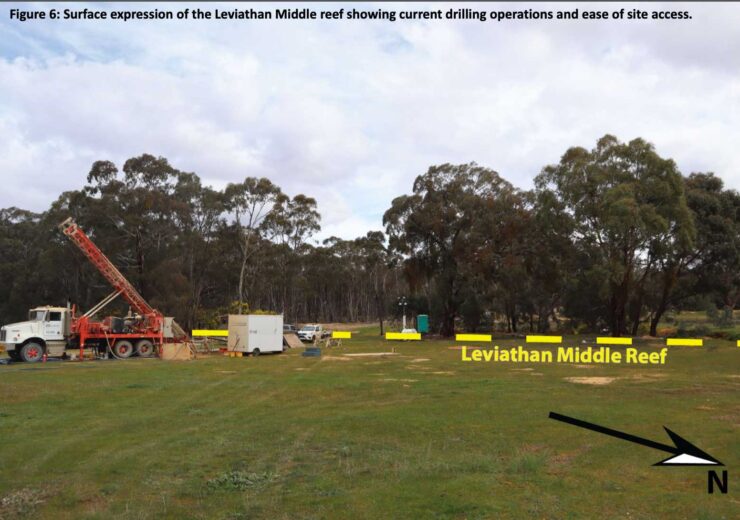Initial 3,000 meter diamond drilling program designed to target strike and depth projections of known high-grade gold mineralization in mine workings abandoned in 1905

Leviathan Gold Ltd. announces the initiation of drilling at the historic Leviathan Mine, Timor Property. (Credit: LEVIATHAN GOLD LTD.)
Leviathan Gold Ltd. (“Leviathan”, the “Company”) (TSXV: LVX) (Germany: 0GP) is pleased to announce that it has commenced drilling at the historic Leviathan Mine within the Company’s Timor property. This initial phase of work, which is expected to comprise at least 3,000 meters of diamond drilling, has been designed to target strike and depth projections of known high-grade gold mineralization in underground mine workings understood to have been abandoned in 1905. Recorded historic production for the Leviathan Mine – itself an amalgam of closely adjacent shafts and underground workings – is 181,000 tonnes for 67,511 ounces of gold at a grade of 11.4 g/t Au.
Compilation and review of historic mining records and plans together with modern field work by Leviathan’s geological team suggests that gold mineralization at the historic Leviathan Mine is open along strike and at depth – presenting clear drill targets immediately beneath abandoned mine workings, including areas underground development drives that were never fully exploited. These targets occur from depths as shallow as ~70 meters.
Mineralization at the Leviathan Mine is known to occur as quartz veins, stockworks and spurs within a broad north-south trending fault system, itself comprising numerous individual faults. Where mineralized, these are locally termed “reefs”. By 1862 approximately 90 such reefs were reportedly known in the area of Leviathan Mine, with production records suggesting that such occurrences produced “more than an ounce of gold per tonne.”
Writing in 1913 – subsequent to the closure of the Leviathan Mine – the Geological Survey of Victoria3 observed:
“From the surface to 240 feet the Old Leviathan averaged for a long time 1 oz. per ton and the ore was 10 feet to 20 feet wide. At no point lower than 300 feet has this line been worked” and “The 960-ft level, the next level at which the Old Leviathan Reef formation was cut, shows a splendid quartz reef with encouraging prospects, and going strongly underfoot south”, and “The New Reef in in the 960-ft level warrants further exploiting and this should be done if ever the mine is again worked”.
Within the area contemplated by current drilling, repeated parallel to sub-parallel reef targets extend over an area of at least 130 meters laterally and in excess of 750 meters of strike. Preliminary indications are that this fault system persists for several kilometers to the north of the current target, and that parallel systems appear to exist to both its east and its west. These occurrences will be reported on in due course.
Hard rock gold mineralization in the area of Leviathan Mine furthermore appears to have been a significant source for the rich alluvial gold deposits that extend for kilometers downstream of the Leviathan Mine in an area known as the Chinaman’s Flat Lead (“the Lead”) – the scene of a major gold rush in the 1850’s. At this time some 30,000 diggers were reportedly engaged in mining on the Lead, with reports4 suggesting an average yield for the Lead of “four ounces gold to the load” (or approximately 163 grams of gold per cubic metre) and that grades in many shafts (in the alluvial material) ranged from 2 kilograms to 5 kilograms gold per cubic metre.
It is understood that historic operation of the Leviathan Mine ceased due to the inability of the mining, metallurgical and pumping techniques of the day to perform economically at the required depths.
Leviathan Gold Chief Executive Officer, Luke Norman, remarked: “We are very excited to be commencing drilling works at the old Leviathan Mine, our namesake target. Since completing the spin-out our technical and permitting team has been working diligently to gain the necessary permits and access to drill these exciting targets. Compilation and review of historic records by Leviathan’s geological team, in conjunction with new fieldwork suggest that historic mining ceased at relatively shallow levels, leaving multiple, stacked high grade ore-shoots open to depth and along strike. Our plan is to systematically test these features via modern drilling and assaying techniques, confirming their grades and widths, while at the same time continuing to assemble targeting information on what appear to be further reef occurrences parallel to and along strike from the Leviathan Mine”.
Source: Company Press Release
